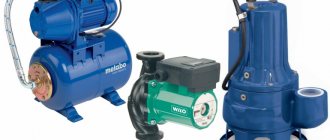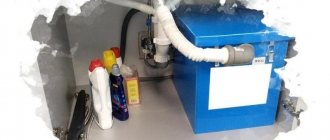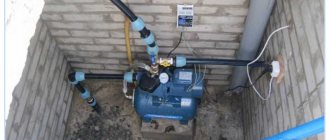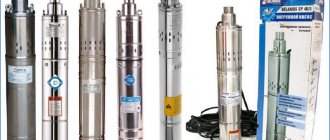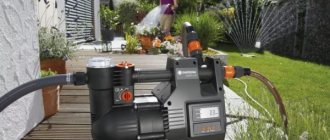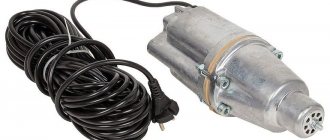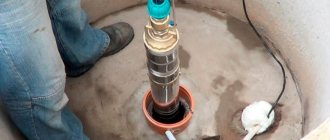Often, owners of private houses decide to drill capital deep artesian wells on their property, and not “in the sand.” A conventional surface unit will not be suitable for such sources. Even with an ejector, it is limited in its ability to lift water depth. A submersible pump that operates at any depth does not have such disadvantages.
For which wells
All pumps are divided into two large groups: surface and submersible water pumps. Each type also has its own varieties (vibration, vortex, etc.).
The submersible well pump is more versatile in its capabilities. It is suitable for any wells, regardless of depth: artesian or needle wells. The limitation is the diameter of the apparatus itself, since it descends directly into the source. This is relative, since modern submersible well pumps have a diameter of 8 cm, which is very small and fits most thin wells.
Submersible well pumps look like a smooth cylinder slightly thicker than the suction hose, making it easier to lower/pull out of the well.
Surface aggregates limited to a sampling depth of 8–10 m.
Thus, there is no need to seriously consider such products for capital wells. For them, there are submersible pumping stations, which, in addition to deep intake, cope with creating decent pressure in the system.
Comparison
The advantages of the pumps in question in comparison with other types:
- Any sampling depth is available (including a semi-submersible pump that can be equipped with a hose)
- no noise
- lower risk of overheating - water itself cools
- There is an automatic system that protects against “dry running”
- a submersible well pump has a guaranteed service life of an average of 3 years longer
- vibration samples resistant to contamination
Minuses:
- high requirements for the insulation of the device itself and the supply cable
- It is more difficult to automate the equipment, but there are already examples with built-in automatic control (pump with a float switch). Ready-made kits with hydraulic tanks are sold
- more difficult to maintain. In order to remove the device, you will have to remove the head and unfasten the cables.
- risk of distortions inside the well, formation of loops by cables. The pump may get stuck inside if there is deposits on the walls.
- characteristics of submersible well pumps include sensitivity to contamination. The exception is vibration units, and submersible drainage pumps are completely designed for dirt
Kinds
Submersible pumps, according to their design features, are divided into two large groups:
- Rod submersible pumps . They are driven using an independent motor. It is located above the surface of the water. This process occurs due to the use of a mechanical connection - the so-called rod.
- Rodless submersible pumps . They are manufactured in one unit together with the engine. It can be either electric or pneumatic. In the first case, power is supplied using a submersible electrical cable.
According to their purpose, submersible pumps are:
- Borehole.
- Wells.
- Fecal.
- Drainage
Due to the large number of private properties in the Russian Federation, borehole and well submersible pumps are primarily popular. With their help, you can ensure the operation of an autonomous water supply system for a private home or cottage. In addition, they are often used, including in various enterprises. This is because in this way a plant or factory can meet its water needs without having to rely on centralized city systems.
How it works, technical specifications
The options and parameters of the device depend on its capabilities, which should be taken into account before choosing a submersible pump for a well.
Nutrition
For a household appliance, a regular network of 220 W and 50 Hz is sufficient. It is desirable that the distribution board have circuit breakers and protective devices that ensure stable operation of the device for delivering water from the well to the house. It must be taken into account that turning on the equipment provokes a surge in electricity. This means that the starting power can be 2 to 3 times greater than the “nominal” power. It is recommended to equip complex equipment with a voltage stabilizer.
Dimensions
The external shape is specially created by manufacturers for the source pipes; as a rule, it is a small submersible pump in the form of an oblong cylinder.
There are many diameter options. Standard rule: select a device 20 - 30 mm thinner than the pipe. If the design of the submersible pump includes float automatics, then this rule may not apply, then you need to look at the manufacturer’s recommendations.
The height of the mechanism, before installing the pump in the well, is selected according to the following parameters: the thickness of the water layer, the flow rate of the source and dynamic changes during intake. Each model in the instructions has a specified minimum height of suspension from the bottom of the device body to the bottom of the well (min Hh) and a minimum thickness of the top layer of water to its “mirror”.
Pressure and performance
Submersible pumps for wells have technical characteristics regarding pressure on average within the range of 70 - 100 m of water. pillar. Approximate calculation: 1 bar corresponds to 10 m of water column, but to this value it is necessary to add the force to overcome the hydraulic resistance of pipes, including horizontal sections (10 m horizontally equals 1 m vertical), as well as a reserve of 10 - 20%.
The calculation of a pump for an average private well takes into account that it is necessary to ensure simultaneous operation of a shower, faucets in the bathtub and kitchen, a washing machine and dishwasher, a toilet cistern, and watering the garden. For this, 2500 - 3000 l/hour is sufficient.
Pollution
Any types of submersible pumps are designed for a certain level of maximum concentration of contaminants in water that the device can handle. This is indicated in its instructions.
Example of a pump with a filter at the bottom
When installing a submersible pump in a well, it must be equipped with a filter that traps particles. But if their size and quantity do not meet the stated requirements, then it quickly becomes overgrown.
Parameters of the electrical cable, pipe and cable
These elements of a submersible pump system must be designed for the depth of immersion. Extending or increasing them is very difficult and unsafe. The slightest lack of tightness is fraught with dire consequences. To install the pump correctly, the pipe must match the diameter of the pipe being connected or have the necessary adapters for other sizes.
Additional equipment
Water well pumps are equipped with a built-in filtration system. The recommended option is a water level sensor, which will prevent dry running. Despite the fact that such pumps do not require thermal protection, they should be there.
A hose for a submersible pump, suspension cables, fittings, check valves, shut-off valves, an automatic control unit with a pressure switch - must be included with a quality product. Often the kit also includes a small hydraulic accumulator.
Popular models
Many manufacturers of well pumps have long established themselves in the market. Their products have good consumer reviews. Such companies must provide a warranty card, according to which you can carry out free repair of equipment or exchange it within a specified time.
Among the best pump manufacturers there are both Russian and foreign companies.
| Submersible pump brand | Water supply L/h | Power, W | Water pressure m | Pump diameter mm |
| "Aquarius" | 1800 | 400 | 27 | 100 |
| "Typhoon" | 5000 | 100 | 65 | 102 |
| "Aguario ASP" | 1000 | 460 | 40 | 102 |
| "Water cannon" | 3300 | 460 | 35 | 98 |
| "Belamos SP" | 2000 | 800 | 90 | 96 |
| "Cascade" | 2700 | 250 | 42 | 75 |
| "Aguario ASP 3" | 4000 | 1100 | 90 | 85 |
| "Flux" | 6000 | 800 | 43 | 88 |
| "Flow" | 1500 | 370 | 35 | — |
| "Vodomet PROF" | 3300 | 460 | 35 | 98 |
Each type of well pump has its own advantages and disadvantages. In this regard, when choosing suitable equipment, it is necessary to determine exactly for what purposes the device will be used, comparing all the necessary technical characteristics.
Did the article help you?
Andrey
Ask questions
Ask questions and write answers in the comments
Varieties and their capabilities
Depending on the internal structure, the submersible water pump has several types. They are similar to surface pumps. Each has its own limits of capabilities and operating features for a well according to the parameters inherent to it.
Semi-submersible
Vertical or semi-submersible pumps are partially lowered into the liquid. They are intended for very shallow sources, where the water surface is almost at the very surface.
Semi-submersible pumps consist of a submersible pipe and an upper part protruding from the source, resembling a column, from which the sucked water flows out. Their operating principle is the same as that of centrifugal and vortex ones. For wells, semi-submersible pumps are only suitable if the well is very shallow.
A semi-submersible pump is usually used for pumping water from containers, but it is also possible to install a long suction pipe and use the device for wells.
Slurry
A submersible slurry pump pumps hydraulic slurries, sandy compounds, liquids with solid particles (dirt, earth, cement, etc.).
This is the same centrifugal apparatus, but with a reinforced design.
Centrifugal
Centrifugal submersible pumps have chambers inside the housing in which special disks with blades create a centrifugal force that pumps water. More specifically, the operation of wells using electric centrifugal devices is as follows. The camera body has the shape of a snail, where a wheel with blades rotates. The impeller with blades creates centrifugal force, the liquid is thrown towards the walls of the chamber. A vacuum is formed in the center, sucking in water; at the edges, increased pressure is formed, which throws water through the outlet pipe with significant pressure.
A submersible centrifugal pump for a well is often called multistage, since to increase the pressure, several chambers are placed in a cascade. This is due to the limited space of the case: it cannot be too thick, so all parts must be placed compactly.
The deeper the well under the submersible pump and the fence, the more steps are needed to create strong pressure, respectively, the thicker and longer the pump. The number of cameras can be from 2 – 3 to several dozen.
Working chambers are called diffusers
Pros:
- no vibration
- silent
- high performance and pressure
- wide range of sizes
- less sensitive to pollution
Flaws:
- complex design
- centrifugal pumps for wells require periodic maintenance work
- sensitive to voltage, therefore require the installation of a stabilizer
Vortex
They, like the previous type, also have a chamber with a propeller and blades, but the principle of pumping water is different. It falls directly on the blades and as a result, suction is created at the inlet and ejection at the outlet. In this case, the mini submersible pump creates a turbulent flow in addition to the centrifugal force, which makes the pressure very powerful.
The operating principle allows us to limit ourselves to a small number of cameras or even one at all, which makes it possible to reduce the dimensions of the product itself. This also makes them cheaper.
Advantages:
- small size, high-quality pressure and pressure
- not afraid of airing
- cheaper
Minuses:
- high requirements for water purity
- wears out quickly
The last two disadvantages are the reason that connecting water from a well through these mechanisms is rarely used among owners of private wells.
Screw (screw)
Inside, the screw submersible pump has a shaft, like a meat grinder. Its coils fit into a special elastic cylinder, in which openings are cut according to their shape. Such a node is called a gerotor pair. Between the coils and cutouts of the cylinder there are cavities that are filled with water. The rotor rotates, moving them, thus creating suction and expulsion.
In private sources, a submersible screw pump is rarely used, since the presence of friction units leads to rapid wear. Among the advantages are the undemanding nature of voltage stability and the creation of a very even, powerful pressure. Such industrial submersible pumps are capable of pumping liquids of any viscosity, including technological ones, which makes them popular in production.
This choice of submersible pump is not recommended for domestic wells due to sensitivity to the smallest abrasive contaminants.
Vibrating
Common for domestic wells, the traditional choice of their owners. The selection of a pump for a well in this case is economical. The intake pipe can be located below or above, the body material is metal or plastic.
Advantages and disadvantages:
- submersible vibration pumps for wells are cheap, their use is economically justified
- consumes only 250 – 300 W
- practical and unpretentious
- there is no electric drive, since there are no rotating parts
- does not require a complex suspension system to the head, since the product is lightweight
- strong pressure but low productivity
- fence depth on average 50 m
- vibrations destroy the walls of the well. That is why such units are recommended for sources in hard rocks; the well must have casing pipes and concrete rings
- vibrations lift silt from the bottom, the liquid becomes cloudy. Therefore, it is recommended to make a high-quality gravel bottom pad before connecting the well pump
- Parts wear out quickly, but they are easily replaced. In addition, the low cost allows you to often buy new products to replace old ones.
The principle of operation of a vibration pump
The principle of how a submersible pump works: there is a magnetic coil inside, which is caused by alternating current to vibrate. Due to this, a steel anchor with a rod and piston is pushed, thus pumping is carried out. The vibration frequency ranges from 50 to 100 per second. Water is pushed to the outlet, and a system of check valves prevents it from flowing back.
A submersible vibration pump for wells provides excellent pressure, but low productivity (about 1000 l/hour versus 3000 l/hour for centrifugal ones). It should be noted that they are as economical as possible: they consume about 280 W and are cheap.
What are deep well pumping equipment?
Well equipment is a device operating on the basis of a centrifugal cycle. Using this device, you can obtain very strong pressure and an optimal supply of clean water with a minimum content of impurities. In addition to individual use, well pumps are used for:
- irrigation;
- water supply in various industries, as well as in fire safety systems.
Industrial deep-well pumps are distinguished by the fact that they are completely immersed in water, that is, they operate below the water level, which allows them to lift a larger amount of liquid from a greater depth. Pumps for wells and wells from the manufacturers presented below do not overheat, which means they do not require additional cooling. During operation, the engine is cooled due to the water temperature, which is 20-26°C.
How are pumps for wells different from well pumps?
Due to the fact that both of these types are very common, they can be confused with each other. But the main distinguishing feature is that well equipment is capable of extracting water from deep sandy and limestone wells. In such places, using well pumps is simply unacceptable. They are of the centrifugal type. They can be used in wells, but mines. Well pumps can work not only in wells, but also in natural reservoirs or special reservoirs. They will be an ideal option for water supply to private plots of country houses.
Installation and operation
The installation and connection diagram of the submersible pump is extremely simple:
- the unit is lowered into the source
- installation of a submersible pump in a well: check for cable distortions; they should all be evenly spaced. For greater reliability, they can be fastened with metal stainless steel clamps every 2.5 m. This will also reduce the risk of loops forming
- must be hung from the head - there must be special brackets and hooks
- if there is a hydraulic accumulator, set it up
- connecting a submersible pump to the network, starting, testing
The operation of wells with submersible electric centrifugal pumps takes into account the fact that they should be checked once every 2 years: inspect for chips, cracks, clean the pipe, filter, test the rotation of the shaft, the tightness of the seals.
Pumps for summer cottages must be equipped with filters. This is especially true for products that have an impeller and screws inside and is less relevant for vibration pumps.
The use of multi-stage devices for sand wells, if there is no filter, quickly clogs their chambers. Then it is better to use the vibration type, but there must be casing pipes or solid rock walls.
What you need to know to choose a product
The product passport indicates its parameters. The water connection diagram takes into account the comparison of the well properties with them. Before correctly installing the mechanism, it is necessary to carry out the following procedures:
- measure the water surface in statistics and dynamics
- find out the depth of the well
- analyze the water for the size and amount of contaminants
- measure source debit, pipe diameter
How to choose high-quality submersible pumps for wells have some nuances. You need to buy a product whose energy consumption indicators are slightly higher.
The productivity must be significantly less than the debit of the well, otherwise the pump will pump out all the water.
Samples
The standard for multi-stage devices is a pressure of 65 - 100 m (water column) and a capacity of 3000 l/h.
For savings, seasonal needs, watering the garden and the like, vibration mechanisms are the optimal pump for water from a well. It is also capable of meeting the most minimal needs of a two-story house. If you want a capital apparatus, then it is recommended to pay attention to centrifugal or vortex products.

